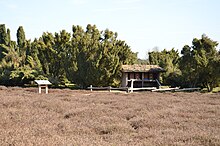Westruper Heide
The Westruper Heide is a nature reserve in Haltern am See between the Haltern reservoir and the eponymous district of Westrup. It is not far from the Haard .
The largest dwarf shrub heath area in Westphalia bears the identifier RE-013 and is also designated as a fauna-flora-habitat area (FFH) in Natura 2000 with the number DE-4209-303. It is an important stepping stone in the biotope network of moors and heaths in the southern Münsterland .
Today's 87.72 hectare area is bounded by the B 58 in the north and the L 652 in the east. There are narrow remains of forest along the roads as protective edge areas. To the southwest is a sand extraction area.
Emergence
The remaining area of the sandy heaths that formerly predominated in the Haltern area lies on a post-glacial dune landscape. Heavy agricultural use since the Middle Ages pushed back the original mixed forest through the use of firewood and cattle grazing and reduced the humus layer through tearing . The soil was only by undemanding plants like heather or juniper covered. This heathland declined again in the course of the industrialization of the nearby Ruhr area , when large areas of pine were planted for Ruhr mining . The logs were in great demand as pit wood.
In order to preserve the once extensive heathland for future generations and to make it more tangible, around 63 hectares of it were placed under nature protection in 1936. The natural reforestation was prevented by appropriate landscape maintenance measures; this includes not only tearing, but also extensive grazing in the summer and targeted burning in the winter months.
In 1979 a strong infestation by the heather beetle was found; a young birch forest had weakened the heather by casting shadows. The then State Institute for Ecology, Landscape Development and Forest Planning (today: State Institute for Ecology, Land Management and Forests in North Rhine-Westphalia ) developed a new maintenance concept, which was implemented in the following years with numerous participation from the population. First, the young trees were smashed by mulching, then the nutrient-rich humus layer was removed over a large area. The newly growing birch and pine trees removed school classes, clubs and parties according to the care plan.
Since 1993, 200 Heidschnucken and 10 goats have been grazing for five months of the year. In addition, in January or February, the old areas are processed through targeted burning. The resulting ash acts as fertilizer and rejuvenates the heather.
fauna and Flora
In the area there are the following landscapes that are particularly worthy of protection:
- Sand heaths on inland dunes,
- Dry sand grass on inland dunes,
- rare and endangered juniper stands on dwarf shrub heaths or dry limestone lawns and
- nutrient-poor wet ecosystems (heather ponds).
According to Natura 2000, the area is also important for the habitats:
- Beech forests and
- old acidic oak forests on sandy plains.
In addition to the juniper bushes that are up to eight meters high, there are some solitary trees. Besides the common heather , the English gorse and bell heather as well as various lichens and moss species grow.
In particular, heat-loving insect and bird species as well as reptiles populate the heather, for example:
- Tiger beetles , silk bees , digger wasps , beewolves and ant lions ,
- Woodlark , Black Woodpecker , Turtledove , Stonechat , Whitethroat , long-eared owl ,
- Smooth snake , sand lizard and various species of grasshopper .
Recreational use
The Westruper Heide is a very popular local recreation area, which is why great importance is attached to managing the flow of visitors. There is a parking lot on the L 652 at the southern tip of the area and several on the B 58, parking is prohibited on the streets themselves. There are information boards at the parking lots and entrances, and from Hotel Seehof there is a barrier-free partial route for people with limited mobility and eyesight (tactile path).
A network of over ten kilometers of sandy paths (dune, bees and forest-heather route) runs through the area, the intersections are highlighted by means of slides . These sidewalks are intended to inhibit the development of beaten paths, wild paths are being dismantled by volunteers.
The entire concept of visitor guidance was developed by the Vestische Umweltzentrum and the landscape architect Hoff in cooperation with local heritage and nature conservation associations as well as local gastronomic and tourist partners and was awarded in the state competition Erlebnis.NRW in 2008 . The state of North Rhine-Westphalia and the European Union are funding the measures with a grant of 160,000 euros. In addition to the paths and the information on offer, the concept also includes the design of adventure points such as the viewing dune and the beehive.
Guided tours are offered in August and September, when the heather is in bloom. Every two years there is a heather festival in August. On Heidetag , the local history association Sythen, the beekeeping association, a shepherd and an information vehicle from the Hohe Mark nature park and the Vestische Umweltzentrum provide information about nature conservation work in the Westruper Heide.
See also
Individual evidence
- ↑ Natura 2000 no. DE-4209-303 Area name Westruper Heide: Quality and meaning ( page no longer available , search in web archives ) Info: The link was automatically marked as defective. Please check the link according to the instructions and then remove this notice. (PDF; 8 kB)
- ↑ home club Sythen: Heidetag 28 August 2011
Web links
- "Westruper Heide" nature reserve (RE-013) in the specialist information system of the State Office for Nature, Environment and Consumer Protection in North Rhine-Westphalia
- Natura 2000 area
- Map of the nature reserve according to Natura 2000 (PDF; 1.1 MB)
- Lanuv information flyer on Westruper Heide (PDF; 727 kB)
Coordinates: 51 ° 44 ′ 13.9 " N , 7 ° 14 ′ 12.2" E







